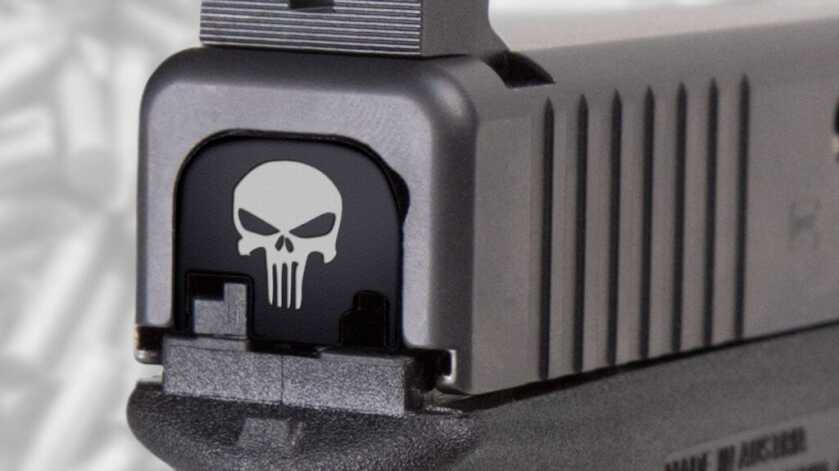
“You’re f***ed.” These two words were laser-engraved on the dust cover of Officer Philip Brailsford’s AR-15, the same rifle he used to shoot Daniel Shaver, who was unarmed at the time. During trial, prosecutors argued that those words were indicative of Brailsford’s mindset when he shot Shaver. A judge ruled photos of the engraving inadmissible, but what if he hadn’t? What if the jury had seen what Brailsford chose to engrave on his gun?
The System Isn’t Necessarily on Your Side
The legal peril after a self-defense incident is real, and the middle of a criminal or civil trial is not the time to be worried about what you might have inscribed on your gun. While the judge’s decision to not allow evidence of Brailsford’s engraved gun was in the officer’s favor, there are no guarantees that would happen to you. Prosecutors will always try to introduce evidence that paints the shooter in a bad light, and judges have the ultimate power to decide what the jury can or can’t see during a trial—often limited only by whether the evidence the state seeks to admit is “more prejudicial than probative.” As you can imagine, different judges can have vastly different ideas about what this means.
Odds vs. Outcomes
Simply put, engraving aggressive or violent slogans on your self-defense gun isn’t a good idea. Whenever this conversation comes up online, someone will say, “Show me a time someone was convicted because of something they had engraved on their gun!” Of course, this is impossible to prove; you’d have to be able to read the mind of every juror involved in a case to find out why they voted “guilty.” The problem with this line of thinking is that it misrepresents self-defense and legal defense as a problem of odds and not an issue of potential outcomes.
What does that mean? If you’re reading this, there’s a good chance you own a gun for home defense and might carry a gun for personal protection outside the home. You don’t expect to be the victim of violent crime, and statistically speaking, you won’t be. The odds of you being attacked are low, but the potential outcomes of being attacked could be life-altering or life-ending. So, you carry your gun because you accept there is a chance you might need it, and having it means that your potential outcomes could be positive instead of negative.
Self-Defense Doesn’t Stop After the Incident
U.S. LawShield members take that logic to the next step. They accept that if someone needs to use a firearm (or any legal weapon, for that matter) in self-defense, there will likely be criminal or civil legal issues afterward. They’ve prepared for those potential outcomes with Legal Defense for Self Defense from U.S. LawShield. If you accept that you might need to use your gun in self-defense, and you also accept that there might be legal troubles after the bang, then wouldn’t you want to do everything you can to avoid those troubles before they happen?
Be Prepared Before the Incident
How is taking a self-defense shooting class from a reputable trainer the same as not engraving aggressive phrases or logos on your gun? They’re both actions you can take before a self-defense incident that will help you prevail in the immediate situation and potentially keep you out of legal trouble later. If you’re on trial for murder, the last thing you want is the prosecutor to show the jury “Exhibit A”—your gun with “smile and wait for the flash” engraved on the muzzle. Remember, the prosecutor’s job is to win, and you don’t want to make their job any easier!
SEE ALSO: Avoid Talking Yourself Into Handcuffs: What Not to Say After a Self-Defense Incident
The prosecution has introduced gun modifications or gear choices in some self-defense cases. As reported by the American Handgunner in their January 2006 edition, one such case is Commonwealth v. Tessitore; prosecutors argued that the laser sight mounted on the defendant’s pistol indicated he wanted to kill people. If that’s what a prosecutor would say about a common self-defense modification, imagine what they’d say about a handgun slide or pistol grips laser-engraved with “COME AND TAKE THEM” and a “Punisher” skull.
Protect Yourself
Remember, the goal of all self-defense is to protect your life or the lives of your loved ones, and that also means protecting yourself from legal jeopardy. If you accept that the world is a dangerous enough place to carry a gun, then it also follows that putting hostile engravings on your self-defense gun could potentially cause you legal trouble. U.S. LawShield members have access to their state’s Independent Program Attorney, who can answer more questions about the potential legal ramifications of engraving messages on self-defense guns.

US LawShield is a great idea, just like wearing a seat belt. No one drives with the intent of getting into an accident; you want just-in-case protection for an unlikely event. Unfortunately you have Leftist states like Washington in which it is illegal to purchase such protection. That law sure seems unconstitutional, but if you think about how that would be challenged in court (with a super Leftist state “Supreme” Court) you can see it won’t change.
Agreed.
No need to hand ammunition as to; attitude, point of view or perspective to a prosecutor or a civil-suit attorney.
Choosing to defend one’s self is hard enough alone to explain these days.
Todd.
With a “range gun” the odds of gun art becoming a legal liability is hopefully greatly reduced. I have laser engraved rear slide stops on several CCW that are the EGA or 2A. Skulls might be cool looking but I will NOT chance something like that on weapon carried regularly for self defense.